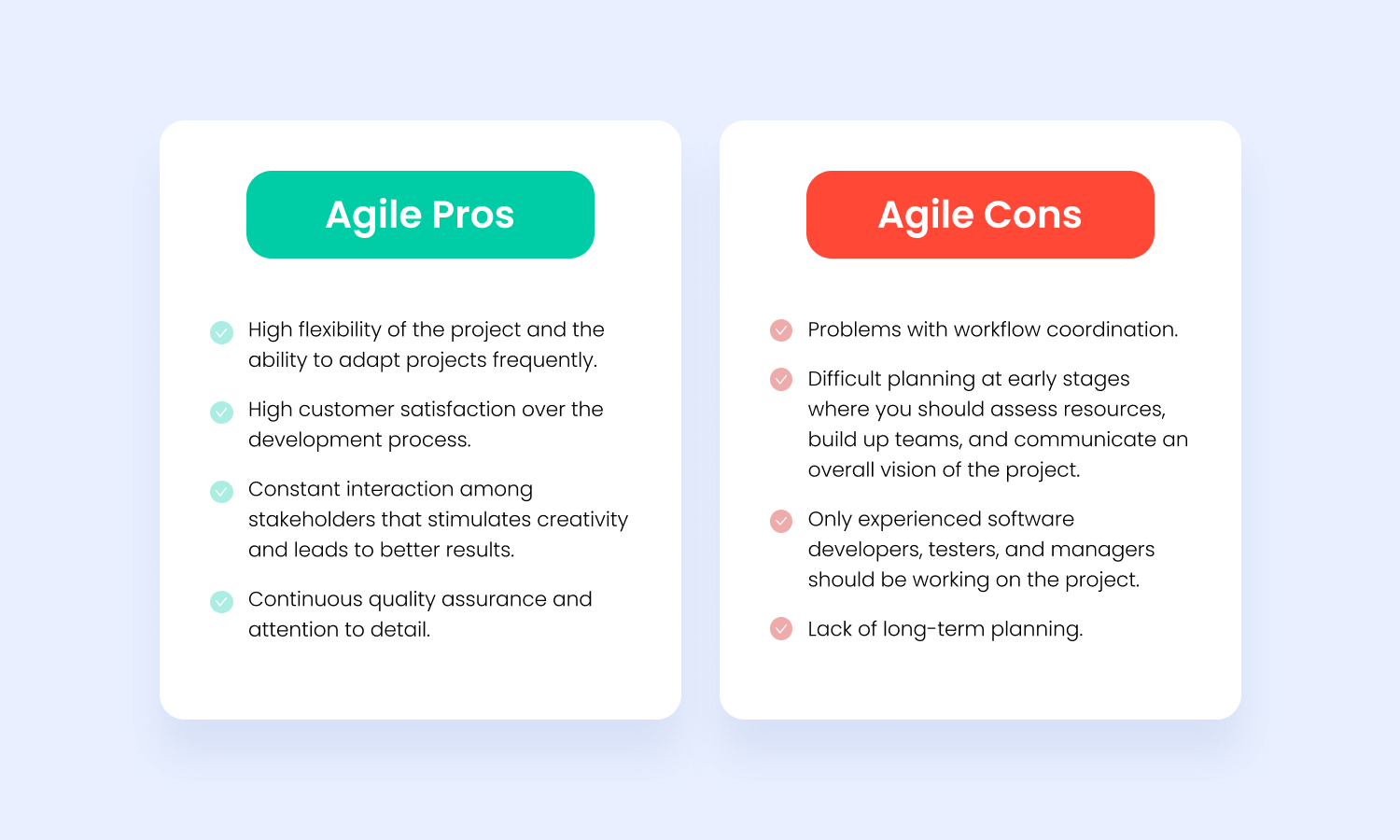Agile Development Advantages and Disadvantages
Users whose professional activities are related to developing various projects probably know it is quite challenging to unite several people to solve one problem. Agile development helps to organize the work of the team, take into account the wishes of the customer, and also allows you to make adjustments at any stage of the project creation.
Ideas and Principles of Agile Development
Agile development benefits include four key principles and 12 principles of effective project management. That is why all Agile management systems are based on the same attitudes and principles (although the variations in their use may be different).
Here are the main settings of the Agile development methodology:
- Human interaction is much more important than technical processes.
- Software is more important than documentation.
- Understanding the client and mutually beneficial cooperation with him is more important than the contract and negotiation of conditions.
- The ability to make adjustments is more important than the original plan.
Next, let's move on to the principles of agile development:
- Deliver software to customers in advance and at regular intervals.
- Make adjustments throughout the development process, changing the requirements for the final SaaS (if you can make a perfect project, you should not focus solely on the original goal).
- Deliver software as often as possible.
- Interact with the client throughout the entire workflow.
- Set the right motivation for all members of the work team (employees who are satisfied with working conditions and motivated by additional bonuses do their job much better).
- Establish a system of direct interaction between developers (this contributes to more successful and productive communication).
- Measure progress solely through working software (customers should only supply functional and working software).
- Constantly work at the same pace (maintain optimal speed to maintain productivity).
- Pay attention to design and technical details (this is an integral part of regular SaaS product improvement).
- Make every effort to simplify your workflow and create software that most people understand.
- Allow the participants in the development process to make their own decisions in the course of work (self-organization, a sense of responsibility and unhindered communication with colleagues significantly increase the likelihood of creating a quality SaaS).
- Constantly monitor technical progress and new trends (without this, the product is unlikely to be able to compete).
Features of Application Agile Development
It is worth noting that visual control is the foundation of Agile product development. In most cases, all employees working on a project use special colored cards. That is, a pre-selected color signals the completion of a certain stage of work: for example, red means the end of planning for some element of the final SaaS, green means it is ready to develop, etc. Thanks to visual control, each team member has an idea of the progress of the workflow.

According to one of the principles of Agile, during the development of a project, the client and the members of the working team constantly interact with each other. This greatly simplifies and speeds up the processes associated with the awareness of project participants. Plus, close cooperation contributes to creating a comfortable working atmosphere and ensures the maximum level of trust and mutual understanding, that is, it has a positive effect on the final SaaS-based product development.
If the project manager, specialists and the customer work together, the risk of misunderstanding the goals and distortion of information is completely eliminated. Everyone will be able to follow the workflow, express their assumptions and ask questions, which means that all problems arising in the development process will be solved almost instantly.
Particular attention should be paid to the role of the project manager. He does not just give instructions to his subordinates, but rather is a recognized leader of the development team, setting the direction of work and determining the rules for the interaction of participants. That is, Agile management can be considered adaptable.
Agile development most often begins with dividing the entire scope of work into small parts. This greatly simplifies the workflow and allows each group to focus on their assigned task.
Working in a project team, employees gain new knowledge, expand their capabilities and learn from mistakes. It is the continuous development of specialists that makes it possible to avoid such mistakes in the future and to end up with an ever-more perfect product.
Sprints and daily meetings are the next essential elements of Agile project development. Sprints are time frames limited by a strict framework, during which a team must solve some specific tasks. The passage of sprints demonstrates the work of the team over the past period of time.
All the time allotted for project development is divided into several sprints, for example, by 10. All sprints have the same duration (say, 7 days). During each period, participants should meet with each other daily to discuss past and forthcoming work.
Moreover, one meeting should not be more than a quarter of an hour. During such meetings, each specialist must answer himself three basic questions:
- What was I doing yesterday?
- What will I do today?
- What is hindering my work?
Answers to the listed questions allow you to control the work process as much as possible, understand at what stage each member of the project team is, as well as eliminate potential difficulties on the way to achieving the goal. Thus, the main conditions for applying agile development methodology are:
- clear designation of a common goal and adherence to it;
- close interaction with the customer;
- division of the total amount of work into parts;
- division of the work collective into small groups from 7 to 9 people.
Advantages and Disadvantages of Agile Development
While learning the basics of Agile development, it is worth paying attention to both the advantages and disadvantages of this methodology. To begin with, we propose to consider its advantages.
Advantages of Agile Development Methodology
First, Agile management has maximum flexibility. If traditional development provides for specific stages of work, Agile easily adapts to the consumer of the final product and any client's requests.
Secondly, using Agile methodology allows you to get a better SaaS since quality assurance is carried out at the end of each sprint.

In addition, Agile development is easy to start, quickly responds to changes, and also allows you to maintain the closest possible connection between the customer and the project team in the course of work. Separately, it is worth noting the level of development security in Agile projects. However, a seemingly ideal methodology has its drawbacks.
The most important benefit of Agile development is getting a SaaS that can be used as early as possible - (MVP) Minimum Viable Product. It also makes it possible to quickly assess the current and potential effect of the product, assess potential costs and decide on further product development or project closure, if necessary.
Disadvantages of Agile Methodology
It should be noted that the possibility of regular communication with the customer can be viewed not only as a plus, but also as a minus. So, the deadlines for the delivery of the finished project can be constantly postponed since the customer, seeing the intermediate results, can demand more and more improvement of the final SaaS, greatly delaying the workflow.
In addition, the flexibility of the Agile methodology implies not only the possibility of making changes to the SaaS being developed, but also the need to include appropriate adjustments in the project documentation. The absence of changes in the documentary component of the project can greatly complicate the work at the subsequent stages.
Another disadvantage of Agile development is the daily meetings of the team members. It is believed that such meetings increase the efficiency of the work process. Still, regular distractions from business can negatively affect the result since the attention of specialists is systematically diverted from the tasks at hand.
The disadvantages of Agile methodology also include the need for constant customer involvement, the lack of stable requirements for the final result, as well as the need for motivated and highly qualified specialists. The last point is especially important for implementing Agile in the company's activities. Therefore, before using Agile methodology, it is necessary to study all the important nuances carefully.
How to Implement Agile Development
As we mentioned above, many modern companies use various agile development methods in their activities. And almost all Agile users agree that implementing this methodology requires careful preparation.
First, you need to choose the best agile development method, which will depend on the conditions of a particular project. After that, tasks and goals, project deadlines, the number of sprints and their duration, the composition and number of working groups, etc., are determined.
The implementation and subsequent use of the Agile methodology should be carried out by highly qualified specialists (Scrum Master). All team members should be familiar with the key Agile principles and principles and be able to apply them in practice. If the organization does not have such employees, subordinate employees should be sent for training.

Before starting the implementation of Agile, the company's management must objectively assess the need to use the methods under consideration and honestly answer the questions: is the organization ready for change, is it possible to use Agile methods taking into account the specifics of the enterprise, etc. In most cases, you have to contact to Agile specialists.
If the need for Agile implementation was nevertheless established, an experienced specialist should be invited who will talk about the mechanism of the system's functioning, sprints and daily meetings, interaction with the customer, etc. Under his control, a new team is formed, working groups are defined, tasks are set, and tools for documenting workflow, etc.
The final stage in implementing Agile SaaS development will be considered the first experience of its application. Of course, mistakes, inconsistencies and shortcomings are indispensable. You may have to replace some tools with others or redistribute roles in the team because the first experience is a two-way adaptation process: the organization learns the nuances of the new methodology, and the methodology adjusts to the company's activities. If this approach looks like what you would like to apply for your SaaS product, then let's discuss your options. Our managers will help you to hire a software development team that will follow all the rules of the agile method.
